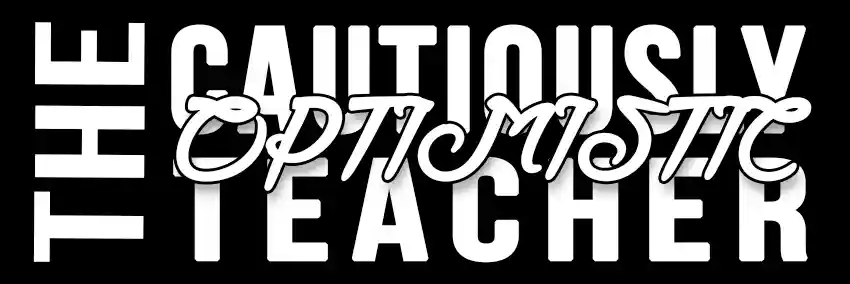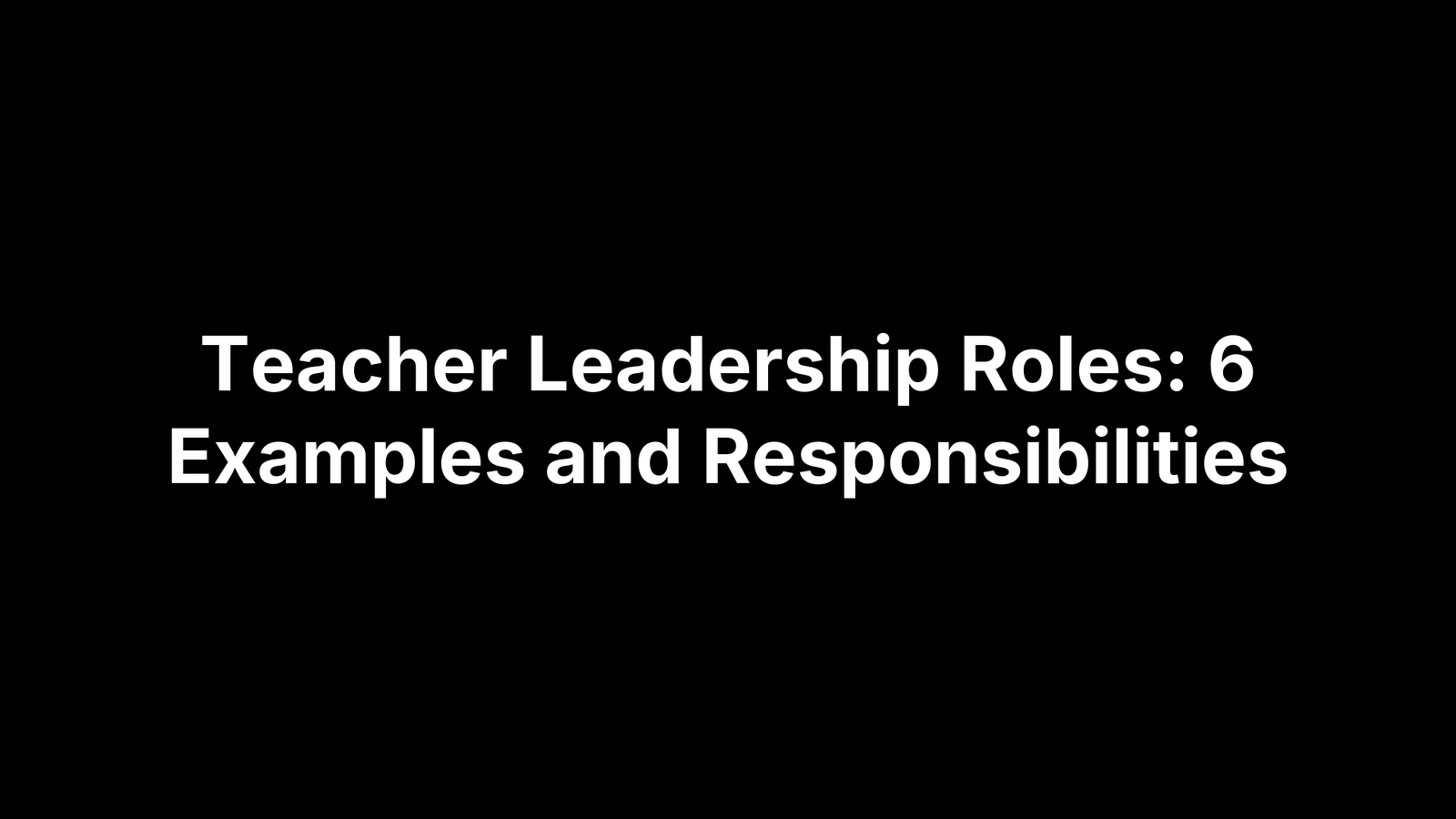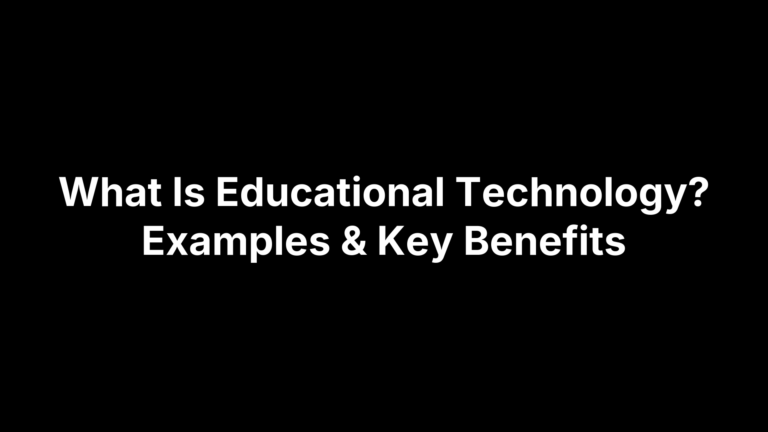Teacher Leadership Roles: 6 Examples and Responsibilities
You want to make a bigger impact without leaving the classroom—but “be a teacher leader” can feel vague, political, or like one more thing on your plate. Roles blur, titles change by district, and it’s hard to know where to start or how to show that your efforts actually move the needle for students and colleagues. What you need is a clear menu of options, realistic responsibilities, and simple ways to track impact so you can lead with purpose, not burnout.
This guide breaks down six practical teacher leadership roles—what each one is, what you do, a real example, tools to use (including quick wins with AI), and how to measure results. Whether you’re sharing resources more strategically, coaching a colleague, tightening curriculum, leading with data, mentoring new teachers, or facilitating a PLC or community partnership, you’ll see how to right-size the work to your schedule and strengths. Let’s start with the role most teachers already play—resource provider—and show how to elevate it from “sharing links” to sustained schoolwide value.
1. Resource provider (using The Cautiously Optimistic Teacher’s AI tools)
Among the most accessible teacher leadership roles, “resource provider” turns everyday sharing into strategic influence. ASCD highlights Resource Provider as a core role, but the impact comes when you curate, contextualize, and close the loop so colleagues can use materials immediately.
What this role is
You lead by finding high-quality materials, vetting them, and packaging them for your context—standards, pacing, and student needs. Instead of flooding inboxes with links, you deliver plug-and-play lessons, assessments, and guides that reduce planning time and raise instructional consistency schoolwide.
Core responsibilities
- Curate high-quality materials: Websites, readings, tasks, and tools aligned to standards.
- Contextualize for your school: Match pacing, demographics, accommodations, and tech access.
- Package for quick use: Ready-to-teach lessons, templates, and student-facing docs.
- Facilitate access: Organize shared drives and give 5-minute “how-to-use” overviews.
- Gather feedback and iterate: Track usage and improve the next drop.
Example in action
Maya’s 8th-grade team struggles to differentiate reading practice. She builds a weekly bundle: Differentiated Instruction Helper tiers tasks, Worksheet Maker produces leveled practice, and Question Generator creates exit tickets—all wrapped in a one-page teacher guide with standards and timing. The team adopts the bundle, reports smoother planning, and aligns on common checks for understanding.
Skills and tools to leverage
Pair curation skills with light systems thinking so resources are easy to find and use.
- Differentiated Instruction Helper: Tiered tasks and supports.
- Worksheet Maker: Fast, leveled practice sets.
- Question Generator: Exit tickets and discussion prompts.
- Shared drive + naming conventions: Consistent, searchable access.
How to measure impact
Define simple, visible metrics so the role scales beyond “sharing links.”
- Adoption rate: Number of teachers using the package.
- Reach: Classes or students served this week/quarter.
- Time saved: One-question survey on planning minutes saved.
- Quality signals: Fewer duplicate resource requests on the same skill.
- Student outcomes: Performance on a common formative tied to the resource focus.
2. Instructional coach and classroom supporter
This is one of the most hands-on teacher leadership roles. Drawing on ASCD’s “Instructional Specialist” and “Classroom Supporter,” you partner with peers to plan, model, co-teach, observe, and debrief so effective strategies show up in real classrooms—not just in PD slides.
What this role is
You help colleagues implement research-based practices through short, focused coaching cycles. The work is shoulder-to-shoulder: plan a lesson, model or co-teach it, gather quick evidence of learning, then reflect together to refine. Peer consultation like this can build teacher efficacy and accelerate action.
Core responsibilities
You design coaching so it’s practical, time-bound, and tied to student needs.
- Co-plan and model: Translate goals into teachable moves and exemplars.
- Co-teach and observe: Share the room to reduce risk and increase feedback.
- Debrief with evidence: Use student work and exit tickets, not hunches.
- Document playbooks: Capture steps, materials, and variations for reuse.
Example in action
After 9th-grade science flags weak lab reports, you invite two ELA teachers to co-create a writing mini-lesson. You model the first class, your colleague teaches the second, and you swap roles for period three. Using a common rubric and exit tickets, the team sees clearer claims and tighter evidence within one week.
Skills and tools to leverage
Keep cycles light and repeatable; pair human coaching with quick AI assists.
- Differentiated Instruction Helper: Tier supports during planning.
- Question Generator: Build checks for understanding and discussion prompts.
- UDL lesson template: Ensure access and variability by design.
How to measure impact
Agree on simple, visible indicators before you start.
- Student evidence: Pre/post exit tickets or rubric criteria.
- Implementation look-fors: Strategy observed in ≥2 consecutive lessons.
- Teacher feedback: One-minute pulse on confidence and usefulness.
- Spread: Number of teachers or sections adopting the strategy.
3. Curriculum specialist and instructional designer
This is one of the teacher leadership roles that multiplies impact across courses and grades. As a curriculum specialist, you make sure standards drive instruction, units build logically, and assessments actually measure what was taught—so every teacher has a coherent roadmap and every student gets a fair shot.
What this role is
You lead teams to translate standards into a living curriculum: clear scope and sequence, shared unit plans, and common assessments with rubrics. You also apply universal design principles so materials are accessible from the start and differentiation is built in, not bolted on later.
Core responsibilities
You turn “what we should teach” into “how we’ll teach and assess it—together.”
- Map the year: Create scope, sequence, and pacing aligned to standards.
- Design common assessments: Blueprints, rubrics, and item banks that match priorities.
- Build unit templates: UDL-based plans with embedded scaffolds and extensions.
- Align across courses: Reduce gaps/overlaps and plan cross-curricular connections.
- Maintain a repository: Version control, naming conventions, and update cycles.
Example in action
A 7–8 ELA team audits units against state standards and finds overlap in argumentative writing. You guide the team to a single, stronger unit with a shared rubric, a calibrated mini-task sequence, and a common performance task. You use Question Generator to seed text-dependent prompts, Worksheet Maker for tiered practice, and Differentiated Instruction Helper to prebuild scaffolds. Within one quarter, teachers report tighter alignment and faster planning.
Skills and tools to leverage
Blend standards expertise with systems thinking and facilitation.
- UDL lesson plan template: Design for variability up front.
- Question Generator: Build aligned prompts and checks for understanding.
- Worksheet Maker: Produce leveled practice tied to targets.
- Differentiated Instruction Helper: Pre-plan scaffolds and extensions.
- Shared drive + templates: Keep everything findable and consistent.
How to measure impact
Make progress visible with simple curriculum health checks.
- Coverage and pacing: % of priority standards mapped and taught on time.
- Assessment alignment: Blueprint match between targets and items.
- Calibration: Rubric agreement after moderation (less score spread).
- Reduction in redundancy: Fewer overlapping units across courses/grades.
- Student evidence: Gains on common formatives tied to new units.
- Teacher time saved: Quick pulse on planning minutes reclaimed.
4. Data coach and assessment lead
Among teacher leadership roles, this one turns numbers into next steps. ASCD names “Data Coach” as a core role: you convene colleagues, surface patterns in student work, and guide teams to instruction that’s responsive, not reactive.
What this role is
You make data usable. That means building simple, shared measures (quick checks and common formatives), leading calm, judgment-free data talks, and helping teams translate findings into small, high-yield instructional adjustments.
Core responsibilities
Keep the focus on clarity, comparability, and action.
- Design common checks: Short, standards-aligned formatives with clear rubrics.
- Facilitate data meetings: Disaggregate, spot trends, and pick one priority.
- Plan responses: Targeted re-teach, small groups, and reassessment windows.
- Build routines: Lightweight calendars, item banks, and storage for evidence.
Example in action
Your 10th-grade team gives a shared writing sample during week two. In a 30-minute huddle, you sort results by class and subgroup, name two rubric rows dragging scores (claims and evidence), and agree on a five-day mini-sequence to address them. A quick reassessment the next week shows more clear claims and relevant quotes across sections.
Skills and tools to leverage
Use low-lift tools and quick AI assists to speed analysis-to-action.
- Question Generator: Build exit tickets keyed to priority standards.
- Worksheet Maker: Create brief, parallel forms for reassessment.
- Differentiated Instruction Helper: Scaffold interventions for specific error patterns.
- Shared spreadsheet + templates: Simple dashboards, item analysis, and rubrics.
How to measure impact
Track a few visible indicators to prove—and improve—your process.
- Mastery gains: Pre/post on the same rubric row or item.
- Cycle speed: Days from assessment to re-teach to reassess.
- Reach: % of courses/sections using the common check.
- Equity checks: Gaps narrowed for identified subgroups on the priority skill.
5. Mentor and peer coach for new teachers
Mentoring is one of the most trusted teacher leadership roles because it blends care with craft. It helps novices acclimate to the school, sharpen instruction, and build confidence—without pushing them out of the classroom. It’s also a clear way to broaden your impact while strengthening your team.
What this role is
You provide relationship-based support to early-career or new-to-your-school teachers. Beyond answering quick questions, you model routines, co-plan lessons, observe and give feedback, and surface the unwritten “how we do things here” so new colleagues can thrive faster and with less stress.
Core responsibilities
You make the invisible visible and the hard parts easier to practice.
- Onboard clearly: Policies, platforms, gradebook, discipline flow, and key contacts.
- Co-plan and model: Use a shared UDL lesson template and exemplars.
- Coach classroom routines: Entry/exit, transitions, feedback, and positive discipline.
- Observe and debrief: Short cycles tied to one or two look-fors.
- Normalize wellness: Time-saving workflows and grading boundaries.
- Set goals: 2–3-week goals with artifacts to show progress.
Example in action
You mentor a first-year 7th-grade ELA teacher for six weeks. Together you co-plan the first unit with the UDL template, use Differentiated Instruction Helper to tier tasks, and pull daily exit tickets with Question Generator. You model day one, co-teach day two, observe day three, then debrief with student work. By week three, your colleague is independently running routines and using the same planning flow.
Skills and tools to leverage
Pair empathy with practical systems so support sticks.
- UDL lesson plan template: Consistent planning scaffold.
- Differentiated Instruction Helper: Built-in scaffolds/extensions.
- Question Generator: Fast checks for understanding.
- Report Card Commentor: Lighten grading-feedback load.
- Checklists + calendars: Observation notes and cadence.
How to measure impact
Keep it simple and visible for both mentor and mentee.
- Goal attainment: % of short-cycle goals met on time.
- Implementation checks: Look-for observed in ≥2 consecutive lessons.
- New teacher confidence: 1-minute self-efficacy pulse each cycle.
- Student indicators: Exit ticket gains on the coached skill.
- Time saved: Quick estimate of planning minutes reclaimed weekly.
6. School and community advocate, PLC/committee facilitator
This is the connective tissue of teacher leadership roles. You elevate student needs, organize adult effort, and create structures—PLCs, committees, and school–community task forces—where ideas become decisions and decisions become action.
What this role is
You facilitate groups to pursue a shared vision: set clear purposes, lift student and family voice, and guide teams to time-bound plans. NEA and ASCD both spotlight teachers who lead PLCs, serve on improvement teams, and represent schools on community committees.
Core responsibilities
You turn meetings into movement by clarifying aims and next steps.
- Facilitate PLCs: Norms, agendas, and cycles tied to student learning.
- Coordinate committees/task forces: Align initiatives to school goals.
- Engage students/families: Ensure diverse voices shape plans.
- Advocate for resources/policy: Elevate needs to admin/district partners.
- Track execution: Owners, timelines, and follow-through.
Example in action
As vision refresh looms, you co-facilitate a mixed group—teachers, students, families. Borrowing ASCD’s approach, you prep student-friendly activities, run two 60-minute sessions, and bring PLC feedback on instruction. The team produces a draft vision and three initiatives with owners and dates.
Skills and tools to leverage
Pair calm facilitation with simple artifacts.
- Agenda + norms template: Purpose, timeboxes, decisions.
- Question Generator: Craft focus questions and protocol prompts.
- Shared tracker (RACI/light spreadsheet): Roles, deadlines, status updates.
How to measure impact
Make progress visible and inclusive.
- Representation: Attendance and diversity of participants.
- Decisions to actions: % with owners, dates, and evidence of completion.
- Family/student voice: Number of ideas incorporated and artifacts collected.
- Initiative outcomes: Milestones met; related student indicators trend up.
Keep growing your leadership
Leadership grows in reps, not titles. Choose the role that matches your strengths and your team’s current need, then start small so you can sustain it. Set clear boundaries, use shared templates, and hold yourself to simple evidence—so colleagues trust the process and you avoid burnout while your impact spreads.
Here’s a quick path you can reuse all year: Pick one role (resource provider, coach, curriculum, data, mentor, or facilitator). Run a 30-day experiment with one team or unit. Measure one outcome (student evidence, adoption, or time saved). Share and scale what worked with a ready-to-use bundle and a two-sentence summary of results. If you want plug-and-play templates, AI helpers, and unit plans to speed this up, explore the tools and weekly ideas at The Cautiously Optimistic Teacher.







